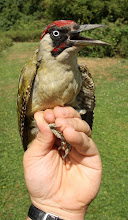... I was ringing at Sandy Smith Nature Reserve and caught 51 birds of 11 species. The standout birds were a single Jackdaw and 16 new Whitethroats.
Today (7th July 2014), I set about putting the same nets up in the same places (something I do almost every time I'm there). Today I ended up with 59 birds of 14 species as follows (retraps in brackets):
Great Spotted Woodpecker 1 (1)
Wren 4 (1)
Dunnock 2 (2)
Robin 1 (0)
Sedge Warbler 1 (0)
Whitethroat 1 (0)
Blackcap 9 (1)
Chiff 1 (0)
Goldcrest 1 (0)
Coal Tit 1 (0)
Blue Tit 2 (0)
Great Tit 7 (21)
Jackdaw 1 (0)
Chaffinch 1 (0)
The highlight one year later was, again, a Jackdaw - the last one I ringed was exactly a year ago today. Funny how things work out!
Above: An adult Jackdaw
Lacking in numbers so far this year (and today), at SSNR, are juvenile Whitethroats. Given the weather conditions have largely been good and food prey species numerous, I can only think that either I've missed them (they're around but just not today) or more likely the heavy rain in May didn't help the breeding success for first broods. The latter may also explain why there is a lack of juvenile Blue Tits around at the moment too as, for the first time at SSNR, Great Tits are far outnumbering Blue Tits. I did, however, catch a Coal Tit today...
Above: A juvenile Coal Tit (one of my favourite birds)
and a ...
Above: A juvenile Goldcrest
Of course, the point of ringing on this day exactly a year later, was because it is the anniversary of the passing of my dad. I wanted time to remember that day and to remember him and give myself some time to grieve a bit. It was a nice day, I got what I wanted and I was pleased with the Jackdaw (truth be told I was hoping to catch one today).
The sale of his house is almost complete. Contracts are exchanged and Thursday 10th July is down as completion day. On Saturday, I took my last things from his house, which included this poem from my childhood:
My Dog
I've got a dog as thin as a rail,
He's got fleas all over his tail;
Every time his tail goes flop,
The fleas at the bottom all jump to the top!
I can't tell you whether I came up with it myself or just copied it, but there's a dodgy drawing of a fat (not thin), out of proportion, dog with fleas jumping around the tail!
Yesterday was the Constant Effort Site ringing at Priory Country Park. Overall numbers seem to be picking up & are certainly better than last year. A new Green Woodpecker (my favourite) was a welcome addition and the oddities came in the form of 2 juvenile Magpies (a species not often caught in mist nets here).
Above: A juvenile Magpie
Finally, I had a bit of a red letter day last week at SSNR (1st July) when I caught 3 Jays. It's unusual to catch Jays here (2 singles have been ringed previously) but I think it may become more common as the surrounding vegetation & young alders become more mature. They may also be taking advantage of my feeding routine. I think I'll let them, don't you?!?
Above: A juvenile Jay. The fluffyness of the underparts being the giveaway to ageing this bird.
All the other Jays now ringed here (4 others) were all adults. The ringing tally was 71 birds ringed of 12 species. This included the first juvenile Reed Bunting to be ringed on site.
Now that the sale of my dad's house is completing, and everything is moved, I am hopeful of having more time to update this blog. Sorry if you've been checking it to find no updates. It's been a long hard slog this year and I now hope to turn my efforts into happier endeavours. But without doubt, that will include more ringing!























